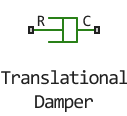Translational Damper
Viscous damper in mechanical translational systems.
blockType: AcausalFoundation.Mechanical.Translational.Elements.Damper
|
Path in the library: |
Description
The Translational Damper unit represents an ideal mechanical progressive viscous damper described by the following equations:
Where:
-
- force transmitted through the damper.
-
- damping coefficient (viscous friction).
-
- relative velocity.
-
- absolute velocities of ports R and C respectively.
The positive direction of the block is from port R to port C. This means that the force is positive if it acts in the direction from R to C.
Ports
R is a mechanical port
` translational mechanics'.
Mechanical progressive port, corresponds to the damper rod.
C - mechanical port
` translational mechanics`.
Mechanical progressive port, corresponds to the damper housing.
Parameters
Damping coefficient, N*s/m - damping coefficient
100.0 N*s/m (by default)
Damping coefficient caused by viscous friction.
Initial value of velocity, m/s - initial value of velocity
0.0 (by default).
Initial value of velocity.
Initial value of force, N - initial value of force, N
0.0 (by default)
Initial value of force.
